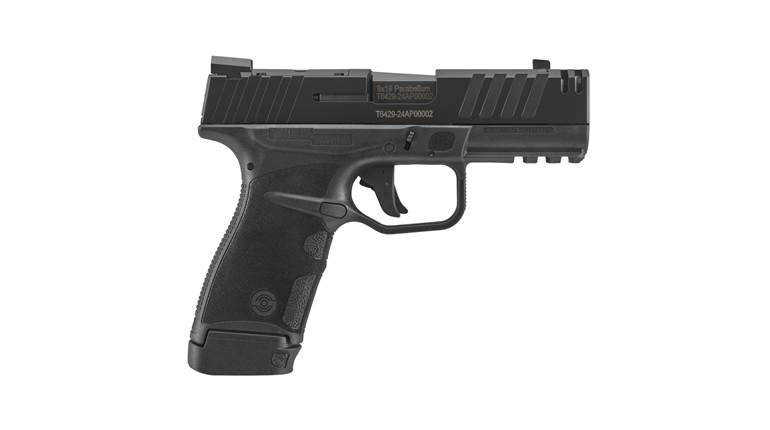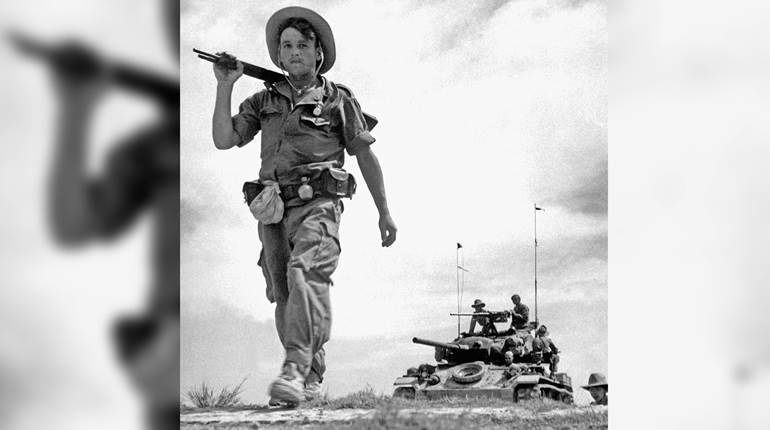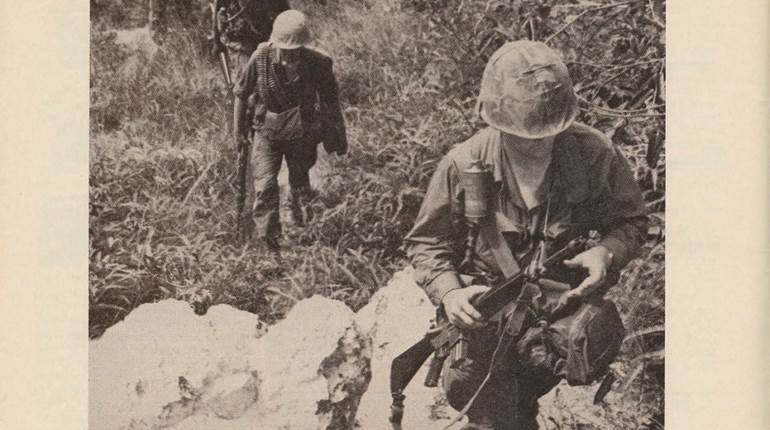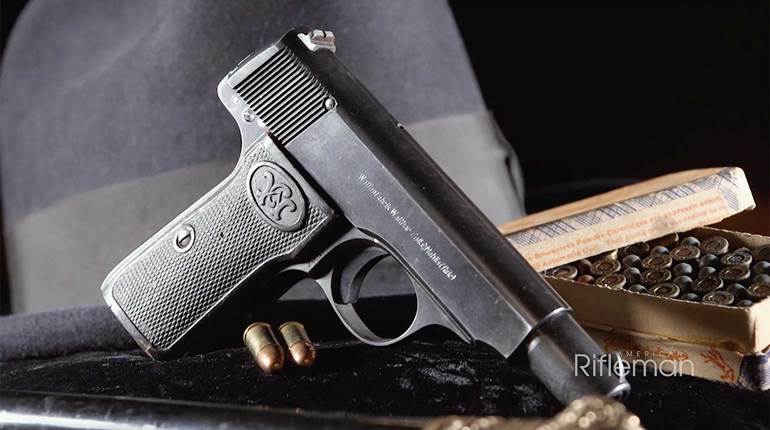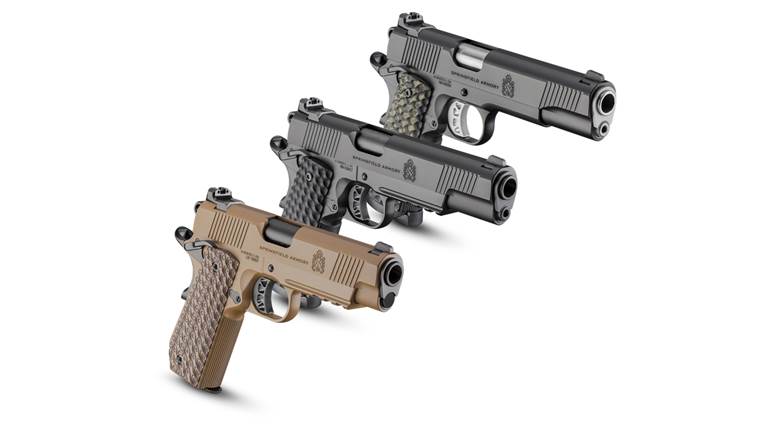
The Swedish K was used by Army Green Berets of the Studies and Observations Group (SOG) during the Vietnam War. The standard combat load was 13 magazines—468 rounds of 9 mm Luger.
It was nicknamed the “green devil,” and it was used by devils in green faces in what could be described as a green hell. The war in Southeast Asia was different from previous wars fought by American troops. The front line was often not defined and sometimes even devoid of a clear enemy. The thick jungle made movement difficult, thus forcing new methods of fighting, including elite units inserted far behind enemy lines attacking supply lines and similar installations.
Various units of the Special Forces employed nonstandard small arms to accomplish their missions, often modifying them in the field. The need for a sturdy, reliable submachine gun, preferably in a silenced version as well, was clear, and various guns were used in this role. One such firearm, favored by Navy SEALs and the Green Berets of the Studies and Observations Group (SOG), was the Swedish-made Carl Gustaf m/45B.
The Swedish submachine gun m/45B or “Swedish K,” really came into its own in the moist and unforgiving environment of the Vietnamese jungle. Born from the ashes of World War II, during a time when the need for submachine guns in Sweden was great, this sturdy, reliable gun was well-liked by the Navy SEALs and other U.S. personnel who used the guns during the Vietnam War.

Origins Of The Swedish K
While Sweden kept out of the conflict, both before and during World War II, it did mobilize its military forces and acquired arms on a large scale. The need for submachine guns—and Sweden had none at the time—resulted in procurement of the Finnish Lahti or “Suomi m/31,” renamed in Sweden the “m/37,” in 1935. At the time, Sweden’s standard pistol was the FN Browning Model 1903 in 9 mm Browning Long (9x20 mm), and the Swedes were reluctant to change to 9 mm Luger, so the m/37 was manufactured in 9x20 mm. As the war drew closer, there were still only about 900 submachine guns in Sweden. A deal was struck with Walther in Zella-Mehlis, Germany, for the purchase of 1,800 Bergmann Model 1935/1, submachine guns—with both long and short barrels—and 1,500 pistols, all of them in 9 mm Luger. The new submachine gun was called the “m/39,” and the new chambering was, a bit reluctantly, adopted as the “9 mm m/39.” The Carl Gustafs rifle factory in Eskilstuna was tasked with altering the existing m/37s to 9 mm Luger, and they were renamed m/37-39s. Another 500 guns were bought from Finland and called “m/37-39F,” with “F” denoting Finland.
The m/37-39 was a very reliable and fine gun; it fired 900 rounds per minute and was fed by a 50-round magazine. A total of 35,000 m/37-39s were eventually manufactured under license from Finland at the two major arms plants in Eskilstuna and Husqvarna. In 1940, 500 Model 1928A1 Thompsons in .45 ACP were bought from Auto-Ordnance, and they were adopted by the Swedish armed forces as the “m/40” submachine guns.
By the end of World War II, Sweden had no less than six different submachine guns in three different chamberings. This was a logistical nightmare when it came to ammunition and spare parts. A task was given to the major arms manufacturers of Sweden, the Carl Gustafs rifle factory of Eskilstuna and the arms factory of Husqvarna, to develop a new submachine gun for the Swedish armed forces. The Husqvarna factory made the “fm/1944” (“fm” meaning forsoksmodell or trial model) and the Eskilstuna factory produced the “fm/1945.” After a brief trial the Eskilstuna entrant was chosen and renamed, becoming the Swedish submachine gun “m/45” in 9 mm Luger.

The original model had an open magazine housing and was fitted with the old “coffin” magazine from the m/37-39 gun with 50 rounds or the 70-round drum. The firepower of the new gun could have been formidable with 70 rounds in the magazine and a controllable and accurate rate of fire of 500-600 r.p.m., but the m/37-39 magazines were notoriously unreliable, so a new magazine was developed, containing 36 rounds instead.
This new magazine was paired with an ingenious device that would enable the filling of a magazine with 36 rounds in less than three seconds. This meant that a soldier on the front line could, in less than a minute, be ready for a long firefight again with four fully loaded 36-round magazines at the ready. Compare this to filling 144 rounds by hand into the magazines, and you understand the wonder of this device.

The Model 45B
The gun was upgraded to the model “45B” some years after introduction. A flaw in the design had been revealed as the end cap could potentially shake loose during use. If that happened, there was a real risk that the end cap, bolt and spring could slam into the shooter’s face when firing, and a “hook” was added on the end piece to prevent this from happening. Finally, the vent holes in the barrel shroud were made smaller and a new green finish was introduced, and what was probably the best submachine gun of the Cold War era was born.
A set of night sights hooked onto the existing sights and consisted of three illuminated dots, providing a reasonable chance of hitting a target in the dark. A brass catcher cloth bag was attached to the gun to collect the spent brass for reloading, but also to prevent damage to the shooter if a cartridge detonated out of battery.
The m/45B was also altered by the SEALs to a silenced version with a long, smooth barrel jacket. Fired with subsonic ammunition, it produced a very low report. This alteration was never made in Sweden.
The operation of the gun is very similar to that of the British Sten gun or the German MP40, with a heavy, open bolt propelled forward by a spring, stripping one round from the magazine, chambering it and firing it with the fixed firing pin. Under recoil, the bolt travels rearward again, ejecting the spent case and, when the recoil spring is fully compressed, the bolt moves forward again, repeating the cycle if the trigger is pressed and there are still rounds in the magazine. An unauthorized and potentially dangerous method was discovered by crafty Swedish conscripts to increase the low firing rate by taking two recoil springs and mashing them together for extra spring tension. Another method was to insert a large cylindrical flashlight battery to increase tension. These methods provide a significantly higher rate of fire, but the risk was that even if the trigger was released, the firing would not stop since the spring tension was too high for the bolt to hook up on the trigger mechanism. This was, of course, not standard operating procedure, and it was not allowed.
The ammunition for the m/45B was the m/39 cartridge, a standard 9 mm Luger load, although Sweden later upgraded the m/39 bullet with a lead core and a steel jacket covered with tombac plating. The wear and tear on the barrel are, however, greater from this bullet. The m/39 bullet had a weight of 116 grs. and a muzzle velocity of 1263 f.p.s., and the m/39B had a 104-gr. bullet with a muzzle velocity of 1345 f.p.s.
The Swedes used the m/45B predominantly on the United Nations missions in Gaza in the late-1950s and in the Congo crisis during 1960-1964. The gun was fitted with a different barrel shroud, sporting a bayonet lug for mounting of the m/14 sword bayonet, normally used on the carbine m/94-14. The reason for this was probably utility during crowd control operations, which were sometimes necessary in Gaza or in the Congo.

American Use
The gun was acknowledged to be reliable and accurate by the U.S. Navy, which, during the 1960s, bought a fair number from the Swedish manufacturer. Two of the big reasons for the use of the m/45B in the Vietnam War was its reliability and its ability to fire as soon as it came out of the water. For this second reason, it was also popular with the Swedish navy divers during the 1960s and ’70s.
The author of this article carried the m/45B for 10 months during his time as a conscript in the Swedish army, and despite neglect, dirt and powder residue, the gun never failed once, and therein lies its greatness. The fighting distances in the Vietnam War were often short, so long-distance accuracy played a smaller role and reliability a larger one. The 36-round-capacity magazine gave an edge in a firefight, and the low cyclic rate of the gun meant that you could very easily stay on target, even during full-automatic fire. The m/45B has no selector switch, so in order to achieve single shots, the shooter must have a quick finger to release the trigger as soon as the gun fires. This is not hard to master, at least not on a calm shooting range, but becomes harder to do under the stress of combat.
A snag encountered by the U.S. Navy as it approached the Swedish government for the purchase of more m/45Bs in 1966 was the Swedish government’s refusal. The reason for this can be debated, but Sweden’s policy was to not to sell firearms to countries at war. Since the need for reliable guns was great, and the introduction of the M16 was not that successful until 1967, Smith & Wesson was contracted to simply copy the m/45B, which became the S&W 76 in 9 mm Luger.
The S&W 76 was not an exact copy but rather a similar gun, using a similar mechanism and magazines. The gun was only used in small numbers, and with the introduction of the XM177E1 and E2 carbine version of the XM16E1/M16A1 firing the more powerful 5.56x45 mm cartridge, submachine guns were used less as the war progressed.
The m/45B was well-liked by the American combat troops, not only in its role as a specialist arm for Special Forces and Navy SEALs. There are stories about other servicemen, not as highly trained as the aforementioned, who used the Swedish K to good effect. One such story revolves around a pilot of a Cessna “Bird Dog” spotter plane. He flew support missions to various bases and was only given a .38 Spl. World War II-era revolver for personal protection, so naturally, he was looking for a replacement. After going through an M16 and a Thompson M1A1, both of which were deemed to be too large and bulky, he managed to acquire a Swedish K, which he liked a lot. It traveled with him for the duration of his time in Vietnam. He even used it, from the cockpit, one-handed against an enemy patrol about to torch a small hamlet.
Another story is of two Marine advisors who were attached to the embassy in Hue City. They acquired two Swedish Ks that they liked for their simplicity and uncluttered design, which they reckoned to be “fine to fight with.” During the start of the Tet Offensive and ensuing fighting in the city, the advisors used their Swedish Ks to good advantage.
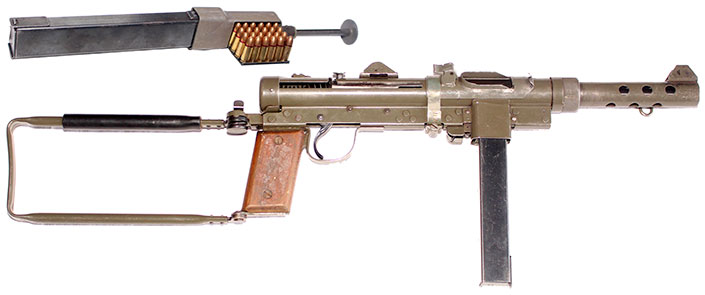
The End Of The Swedish K In Swedish Service
In Sweden the m/45B stayed with the armed forces up until 2007 when it was replaced by the Swedish variant of the FNC carbine. It remained with the home guard for some time, but has now been completely replaced. The Swedish police force used the m/45B in situations requiring more firepower. There were several variations to the gun such as the m/45D, which was capable of semi-automatic fire, and the m/45BCD, which was fitted with a launcher for tear gas cannisters. In 1989, the m/45B was replaced by the Heckler & Koch MP5, which the police still use today. In Sweden, like in the United States, the m/45B is well-liked by civilian shooters and competitors. There is an active, although now declining, number of shooters in Sweden who compete with the m/45B still today. The competitions include shooting from prone, sitting and standing positions on targets at 100, 200 and 300 meters. Due to the political climate in Sweden regarding firearms, and especially fully automatic ones, new licenses for ownership of this wonderful little piece of history are becoming increasingly difficult to acquire, and new shooters are virtually non-existent.
The author’s gun club currently owns a small number of m/45 and m/45Bs, with which we compete at least once a year, just for the fun of it.













